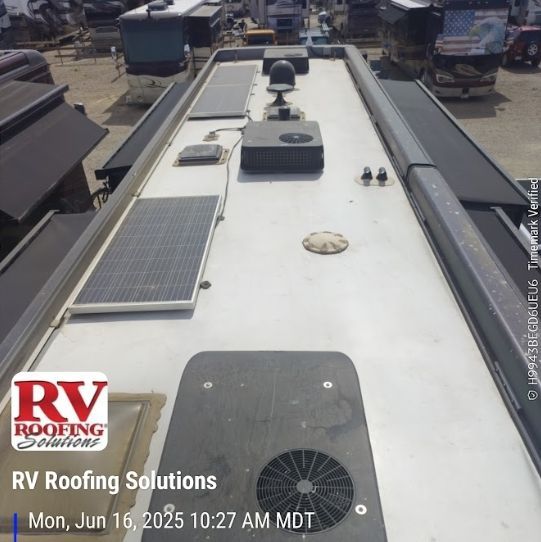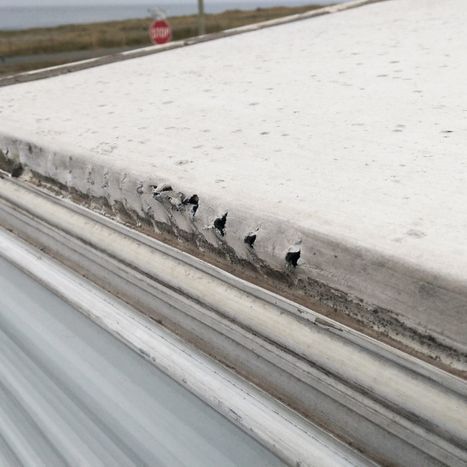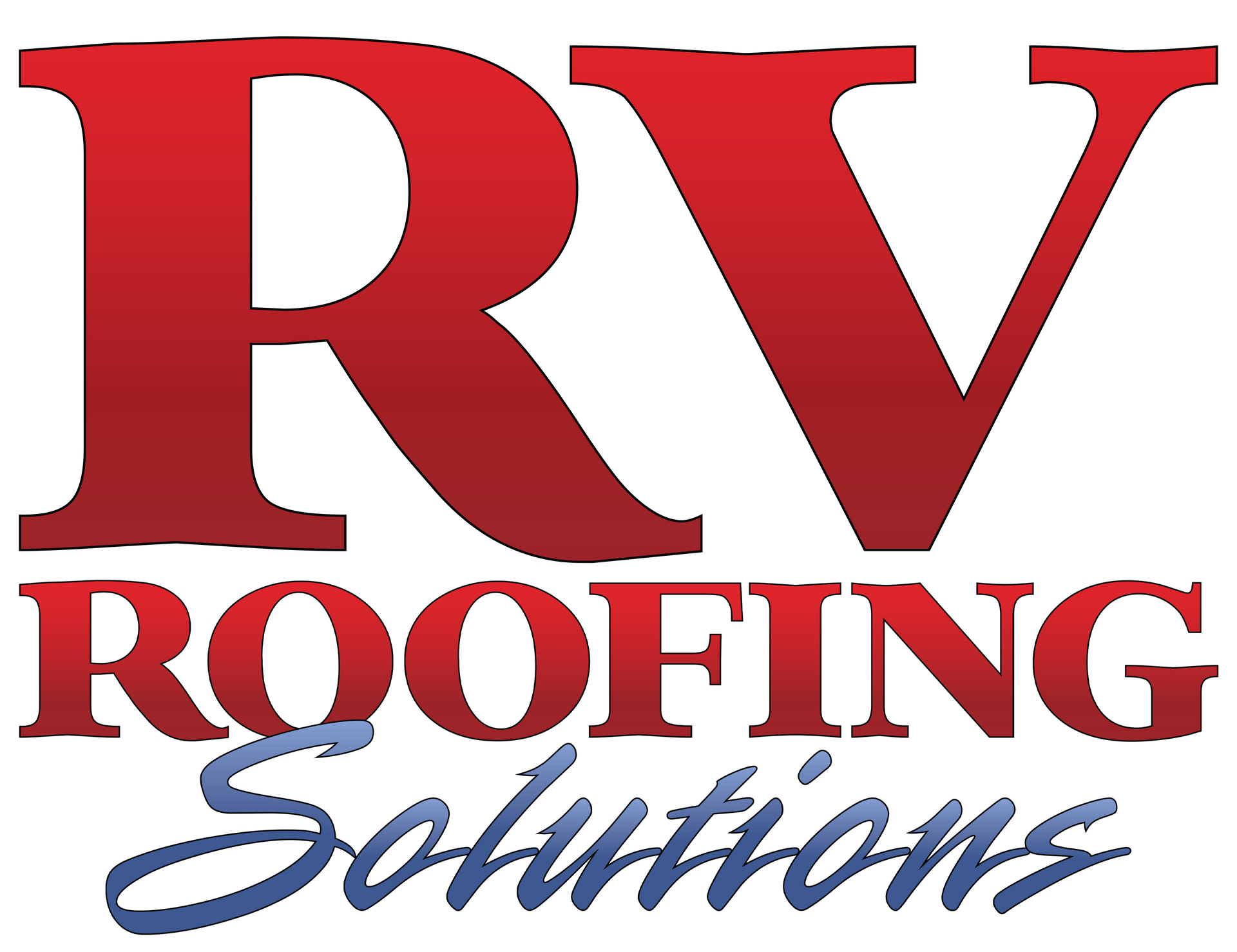Explore & Enjoy the Journey
RV Roofing Solutions' Blog
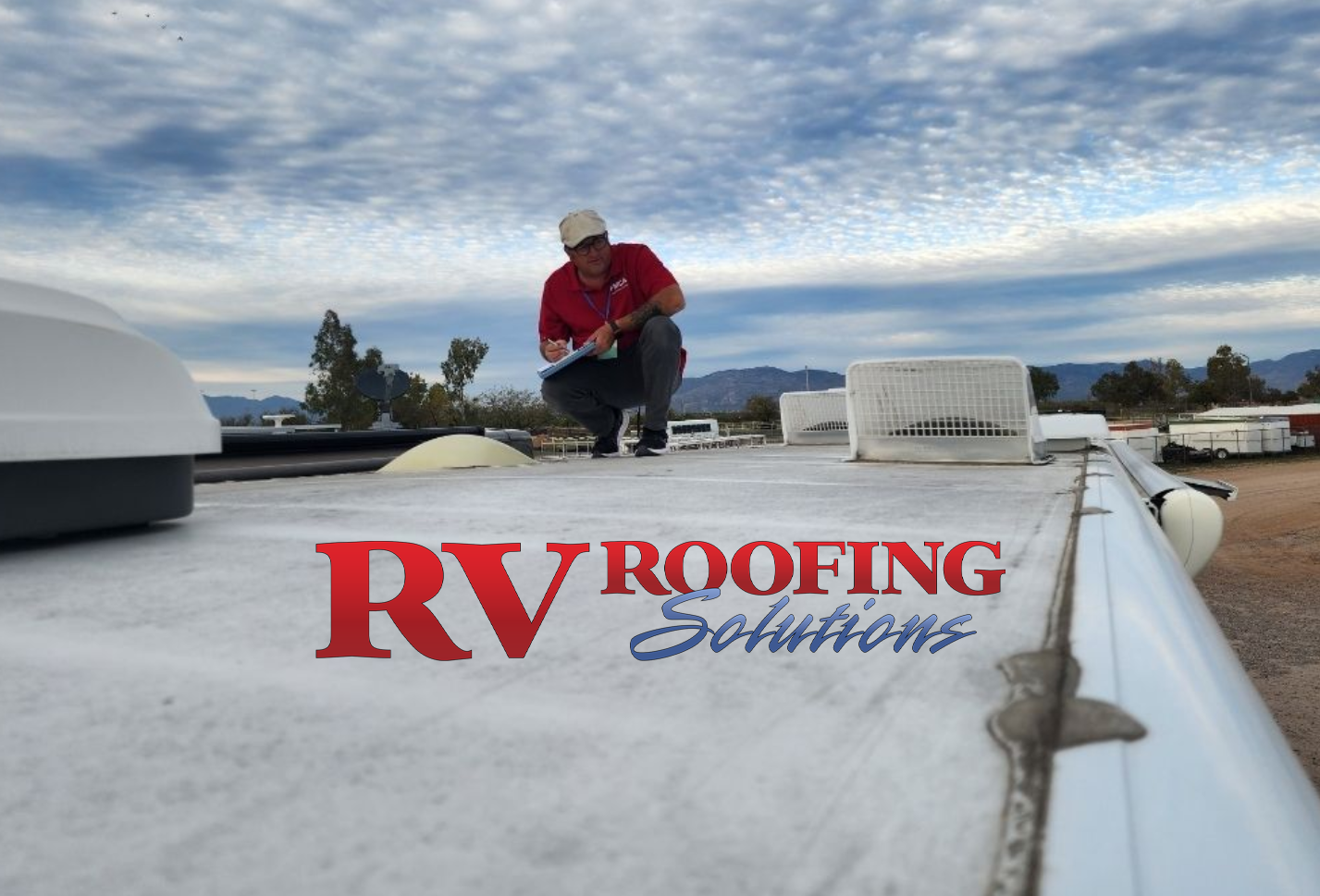
When your home has wheels, your RV roof becomes more than shelter—it’s your shield against the elements, your peace of mind on the open road. That’s why RV Roofing Solutions isn’t just another RV repair company. It's a seamless maintenance free roofing system that can be installed as a prevetative measure to protect your RV or the company you want when it comes to more extensive RV roof repairs. Led by a retired United States Marine Corps veteran and his family, this mission-driven team brings military-grade integrity, precision, and heart to every install. From coast to coast, they’re empowering RVers to demand better—no shortcuts, no excuses, just roofs built to protect what matters most. When Frank Schillaci joined the United States Marine Corps in 1992, he wasn’t dreaming of roof sealant or mobile repairs. He was answering a deeper call—one rooted in honor, integrity, and unwavering commitment to serve and protect his country. As an electronics technician, Frank honed his skills with precision and pride, embodying the values that define the Marine Corps. In 1994, he married Jennifer, and together they built a life grounded in faith, resilience, and love. Through deployments, trainings, and cross-country moves, they raised seven children—navigating the highs and lows of military life with grit and grace. Frank’s dedication never wavered. He served proudly until 2012, retiring as a Gunnery Sergeant after two decades of service. But the story didn’t end there. In 2013, Frank graduated Cum Laude from Liberty University, and the Schillaci family made a bold decision: to hit the road in an RV with six of their seven children (their oldest had just launched into adulthood). What started as a wild adventure quickly became a lifestyle—and eventually, a calling.
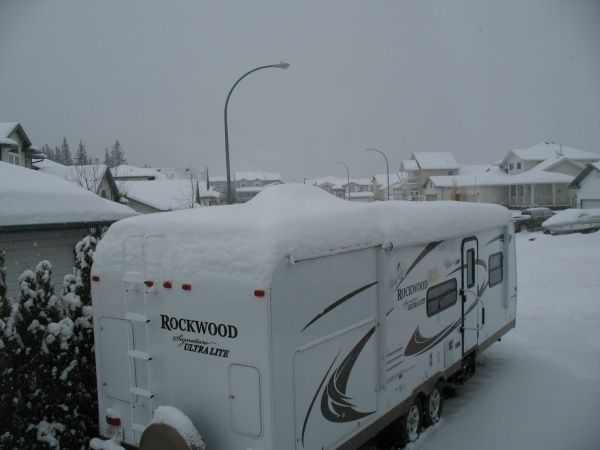
A few weeks ago, we talked about the fall preparation your RV roof needs, like cleaning, sealing, inspecting, and getting ahead of seasonal wear. But this week, I want to ask you a hard question: How do you maintain your RV roof in the winter? Because the impact of cold climates can be far more extensive than most RVers realize. Let's be honest: Many RV roofs really aren't rated for snowpack. Lightweight construction saves fuel and cost, but it also means your roof may not be built to withstand 12–18 inches of wet, slushy snow. That kind of weight can cause sagging, stress seams, and even collapse if structural vulnerabilities exist. And once melting and refreezing cycles begin, water finds its way into every crack, seam, and screw hole, turning minor leaks into major repairs. Double-check a few important details before the frost sets in: • Did you inspect your roof for soft spots or compromised sealant? • How much snow can your roof safely hold? • Are your gaskets and vent seals ready for freezing temps? • Is your roof protected from ice dams and trapped moisture? Winter prepping your RV roof isn't good practice in avoiding expensive damage. You're protecting your rig's value, your travel plans, and your peace of mind. Whether you're storing your RV or heading south, your roof deserves attention before the season shifts. Let's dive into what you can do right now to winterize with confidence. Spooky Season and Your RV Roof: Don’t Let It Become a Horror Story Spooky season brings more than just haunted houses and ghost tours. Falling leaves and colder nights can summon real nightmares for your RV roof. Trapped moisture, brittle seals, and hidden debris are the villains lurking overhead, ready to turn your cozy rig into a costly horror show. Mold, rot, and delamination don't knock. They creep in silently when snow piles up and ventilation gets sealed off. Don't let your roof become the scene of a seasonal scare. Clear off snow and ice with soft tools, inspect seals before the freeze, and avoid the trap of generic tarps that do more harm than good. If you park long-term, consider undercover storage or a maintenance-free roof system like RV Roofing Solutions to keep the monsters at bay. This fall, protect your roof like your rig depends on it — because it does. A little prep now means no jump scares later.
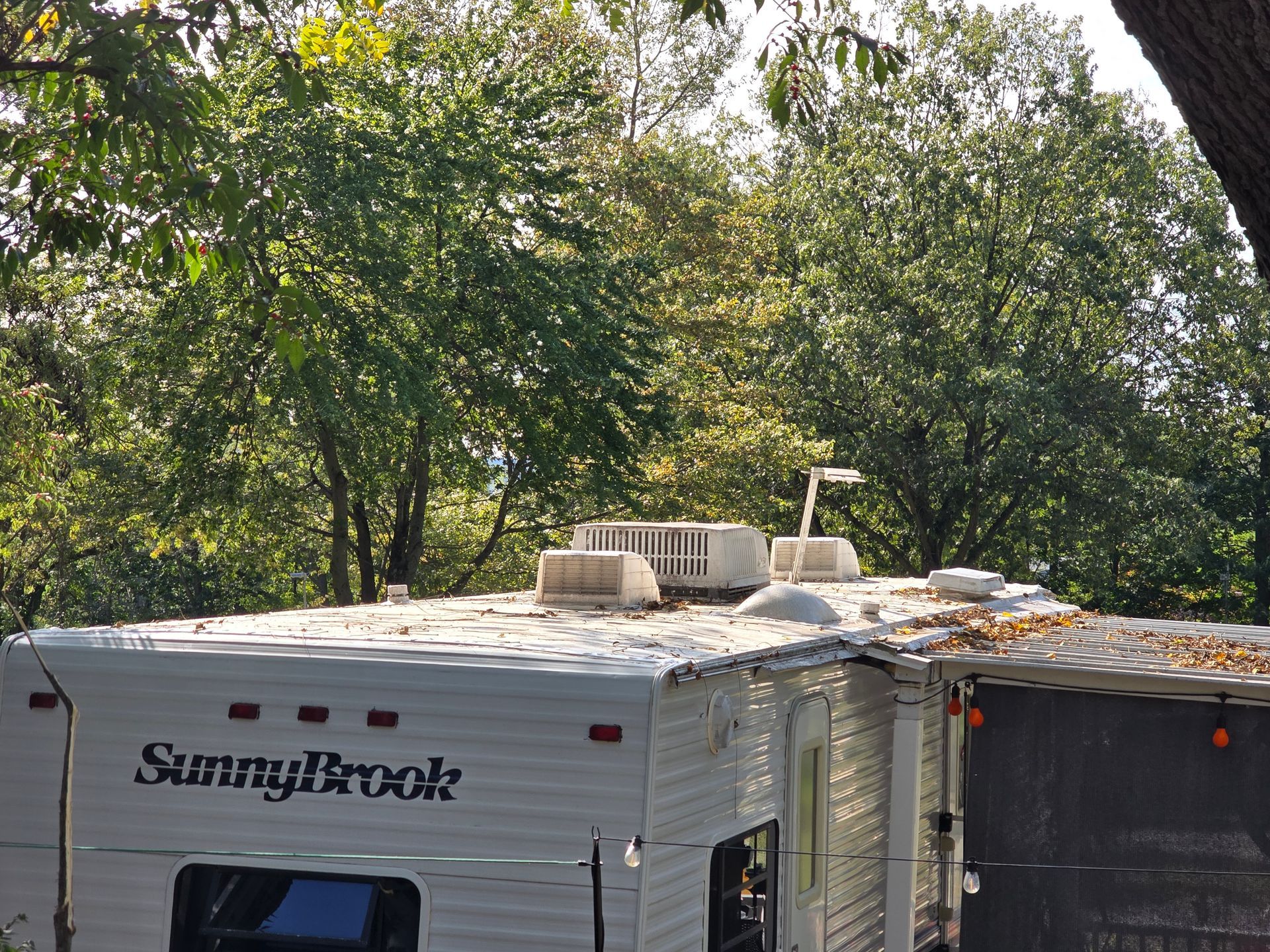
As autumn rolls in with its crisp air and golden foliage, RVers across the country settle into cozy campsites under vibrant canopies of oak, walnut, and maple trees. It’s a season of tailgates, festivals, and fireside memories—but it’s also prime time for unexpected roof damage. Every RVer knows the sound... that sudden thud on the roof. Maybe it’s an acorn, maybe a branch. Your heart skips. The dog starts barking. You freeze, staring at the ceiling, wondering what just landed up there. Each impact, no matter how small, can be a hazard. Acorns can dent or crack your roof membrane. Branches can scrape sealants or wedge into seams. Even leaves, when they pile up, trap moisture and invite mold. And if you’re parked under trees for the season, those hits aren’t rare, in fact they’re often relentless. Whether your roof is rubber, TPO, PVC, fiberglass, or vinyl, it’s your first line of defense. But it’s certainly not invincible. That’s why regular inspections, cleanings, and protective measures aren’t just good practice—they’re peace of mind. So the next time something hits your roof and the dog goes wild, don’t just shrug it off. That sound might be telling you it’s time to check. The Hidden Threats Overhead While falling leaves may seem harmless, they often come with heavier — and more damaging — falling debris that can pose serious risks to your RV. • Acorns,Walnuts, Pecans, Pinecones and small branches: These dense, fast-falling items can dent or crack your RV’s roof's surface, especially if you have a rubber, TPO, PVC, or Vinyl membrane. Over time, repeated impacts may compromise sealants around vents, skylights, or air conditioning units, & the membrane itself, leading to leaks and costly repairs. Regular roof inspections can help mitigate this seasonal hazard. Even though fiberglass roofs tend to hold up better against falling debris, it’s still essential to inspect your RV roof regularly—especially if you're parked under trees. Branches, nuts, and other debris can cause wear over time, and early detection of damage can save you from costly repairs down the road. Tree Sap and Tannins: What RV Owners Should Know Sap and tannins from trees can cling to your RV roof, leading to stubborn stains and surface degradation if not cleaned promptly. • PVC Roofs: These are fairly durable, but sap can stain and dull the reflective coating over time. Regular cleaning helps maintain their appearance and performance. • TPO Roofs: TPO resists mold and punctures, but sap can still stain and weaken UV protection. Heat-welded seams may also be affected if buildup is left unchecked. • Rubber (EPDM) Roofs: Highly vulnerable to sap and tannin damage. These acidic substances can cause black streaks, degrade the membrane, and compromise sealants. • Vinyl Roofs: Less common in RVs, but vinyl is prone to discoloration and surface cracking when exposed to sticky residue. Gentle cleaning is key. • Fiberglass Roofs are more resistant overall, but sap can dull the gel coat and lead to oxidation. Stains may be harder to remove without specialized cleaners. Fall Leaves Can Lead to Roof Damage—No Matter What Type of RV You Own As autumn rolls in, falling leaves may seem picturesque, but they pose a hidden threat to your RV’s roof. When leaves pile up and sit undisturbed, they trap moisture against the surface—creating ideal conditions for mold, mildew, and premature chalking. This is especially problematic around vulnerable areas like vents, seams, and skylights. Whether your RV roof is made of rubber (EPDM), TPO, PVC, fiberglass, or vinyl, none are immune. Rubber and TPO roofs are particularly prone to chalking and microbial growth, while fiberglass and PVC may resist mold but still suffer from staining and sealant breakdown. Regular roof cleaning and leaf removal during the fall season is essential to protect your investment and avoid costly repairs. What Counts as a “Sharp Projectile”? • Acorns and Walnuts: Dense, hard-shelled nuts that fall with force, especially during wind gusts or squirrel activity. • Broken Branch Tips: Jagged twigs and splinters that pierce or scratch roof membranes. • Pinecones and Hickory Nuts: Often overlooked, but heavy enough to dent or crack skylight edges and vent covers. These aren’t just nuisances—they’re roof risks. Why It’s a Problem RV roofs aren’t built for impact. Even minor damage can lead to: • Punctures or Cracks in the membrane, especially on aging or silicone-coated roofs. • Sealant Compromise, allowing water intrusion around vents, AC units, or skylights. • Hidden Moisture Damage, which insurance may not cover if deemed preventable. Membrane roofs, while lightweight and flexible, come with added vulnerability—especially in fall. Their soft surface is prone to punctures from sharp debris like acorns, walnuts, pinecones, or broken branches. Even a tiny pinhole, barely visible at first, can allow moisture to seep in unnoticed. Over time, that small breach can expand, compromising sealants, soaking insulation, and leading to mold or structural damage. What starts as a minor impact can snowball into a major repair. That’s why regular inspections and proactive sealing are essential—and why a seamless roofing system offers far better long-term protection And once water gets in, it’s not just a roof issue—it’s a wall, floor, or even worse.

The roof on your RV isn't just a lid on your rig. It's your best and first defense against weather, wear, and costly damage. So that means fall is more than just falling leaves and crisp air for RVers. It's when we say goodbye to summer adventures and hello to seasonal RV maintenance. Whether you're storing your rig for winter or gearing up for cold-weather travel, here's your autumn checklist to keep your RV roof strong, sealed, and ready for whatever the season brings. And if you're planning to camp through fall, we've got a few extra tips to keep your roof and your adventures well protected. 🍁 Fall Camping Tips for RV Roof Protection • Watch for Falling Debris: Autumn breezes cause tree limbs, acorns, and leaves to fall from above. Park away from heavy branches and check your roof regularly for buildup that can trap moisture or cause abrasions. • Mind the Moisture: Morning dew and cooler temps can lead to condensation. Make sure to properly seal your roof vents and ventilate your interior to prevent mold and mildew. • Check After Storms: Fall weather can be unpredictable. After heavy rain or wind, inspect your roof for pooling water, lifted sealant, or debris that may have caused damage. • Consider a Roof Cover (If Stationary): If you're parked for an extended time, consider a breathable RV roof cover to protect against UV rays and falling debris — just make sure it doesn't trap moisture underneath. There are pros and cons to this that we'll explore later in this article. • Prepare for Temperature Swings: Sealants and gaskets expand and contract with temperature changes. A fall inspection helps catch cracks or gaps before winter sets in. Get Ahead of Winter Prep While Fall Temps Are Warmer Fall offers the perfect window for RV roof maintenance. The weather is pleasant, and the temperatures are ideal for proper curing. Sealants, coatings, and adhesives all require moderate, dry conditions to bond effectively. Once winter sets in, cold temps and moisture can interfere with curing times, reduce adhesion, and compromise long-term protection. Tackling inspections, resealing, and upgrades now keeps you ahead of the freeze and gives your roof the best chance to perform through the harshest months. Whether you're storing your rig or heading south, fall maintenance means fewer surprises and more peace of mind. Wash Your Roof. Thoroughly. Fall is the perfect time to give your RV roof a deep clean. After a season of travel, it’s likely covered in sap, pollen, bird droppings, and road dust — all of which can break down the surface over time if left untreated. Use a soft-bristled brush and an RV-safe cleaner, like Wash Wax All (use code RVRS for a 5% discount!), to gently remove buildup without damaging the membrane. Be sure to avoid harsh chemicals, especially on rubber or fiberglass roofs, as they can strip protective layers and accelerate wear. Pro Tip: Washing your roof twice a year — once in the spring and again in the fall — is ideal for spotting early signs of damage, maintaining your roof’s integrity, and preserving your warranty if you still have one.
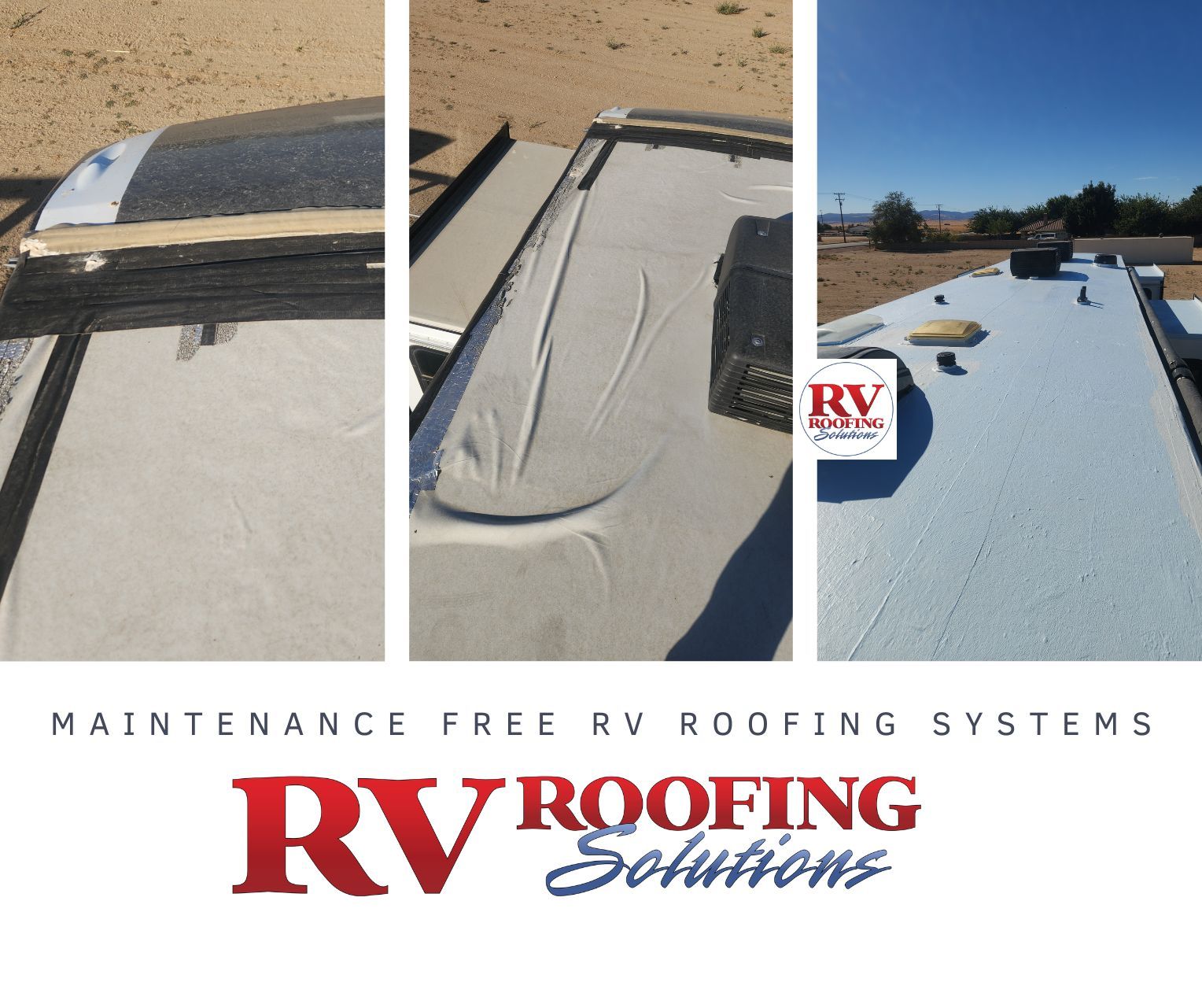
The countdown is on! RV Roofing Solutions is proud to announce our first-ever appearance at the Hershey RV Supershow (it's only taken us 3 and a half years to get in!) , happening September 10–14, 2025 at the Giant Center in Hershey, Pennsylvania—the biggest RV show in the United States. This isn’t just a booth—it’s a milestone. After years of building trust, quality, and community across rallies and service calls, while we have been in Tampa on the national stage for the past 15 years, this gives us an opportunity to showcase what makes our roofing systems different: maintenance-free protection, transparent service, and a commitment to RVers who care about long-term value. Why Hershey Matters With over 1,400 RVs on display and tens of thousands of attendees, the Hershey Supershow is where the RV world comes to connect, compare, and celebrate. RV Roofing Solutions wants to do it all! • Meet customers face-to-face and answer your toughest roofing questions • Offer exclusive show specials and consultations • Connect with fellow vendors, content creators, and industry leaders • Share our story—from mobile service roots to rally favorite to trusted roofing partner What We’re Bringing We’re not just showing up—we’re showing off: • Free consultations to help you plan your roof upgrade & discuss maintenance-free RV roofing systems • Swag and giveaways for RVers who stop by and say hello • A chance to meet the team behind the service—because relationships matter RV Roofing Solutions is proud to be a benefit partner of the Family RV Association (formerly FMCA) and the Tiffin Allegro Club , offering trusted roofing expertise and exclusive perks to their members. As always, we proudly offer additional discounts to veterans, first responders, and teachers. It’s our way of saying thank you to those who serve their communities with dedication and heart. Tasha & Jennifer from The Learn to RV Podcast will be at the booth regularly throughout the event. Especially since Jennifer is there with Frank & RV Roofing Solutions. Plus, we’ll be part of the RV Content Creators Connection on September 8 , where we’ll share insights and stories from the road alongside other voices shaping the RV lifestyle. RV Roofing Solutions will also be debuting a stunning new video at the RV Content Creators Connection—a visual story crafted by the incredibly talented Phil Porto of We Are the Portos . This isn’t just a promo—it’s a heartfelt glimpse into the craftsmanship, care, and community that drive everything we do. We’re honored to share this piece with fellow creators, and we hope it inspires the same passion for quality and connection that fuels our work every day. If you're attending the event, make sure to catch the premiere—it’s something special.

We hear stories like that ALL the time. This week alone, as we've crisscrossed the country, we've spotted at least ten rigs with the same issue. You know the look: the front cap lifting, the membrane bubbling like bread dough rising. But every time we try to grab a photo, it's gone. We're all moving too fast. The sightings are fleeting. Blink and you miss them. It's like chasing a mythical creature—call it the Roof Balloon Beast. Rarely caught on camera, but unmistakably real. And here's the thing: it's not just bad luck. It's physics. Why Does My RV Roof Balloon While Driving? The Science Behind the Problem When your RV cruises down the highway, air flows rapidly over the curved front cap and across the roof. According to Bernoulli's principle, as airflow speed increases, pressure above the roof decreases. Meanwhile, the front cap acts like a scoop, directing air underneath the membrane. If your roof isn't fully adhered, this creates a perfect storm: low pressure above, higher pressure below, and lift—the same force that gets airplanes off the ground. The result? Your roof membrane becomes a parachute, literally trying to take flight. This "parachute effect" is particularly common with TPO and EPDM roofs that rely on perimeter bonding or partial-glue coverage. These methods create air gaps that become vulnerable zones, catching wind and intensifying the problem. What starts as a small lift can escalate dramatically, especially at highway speeds or in windy conditions.
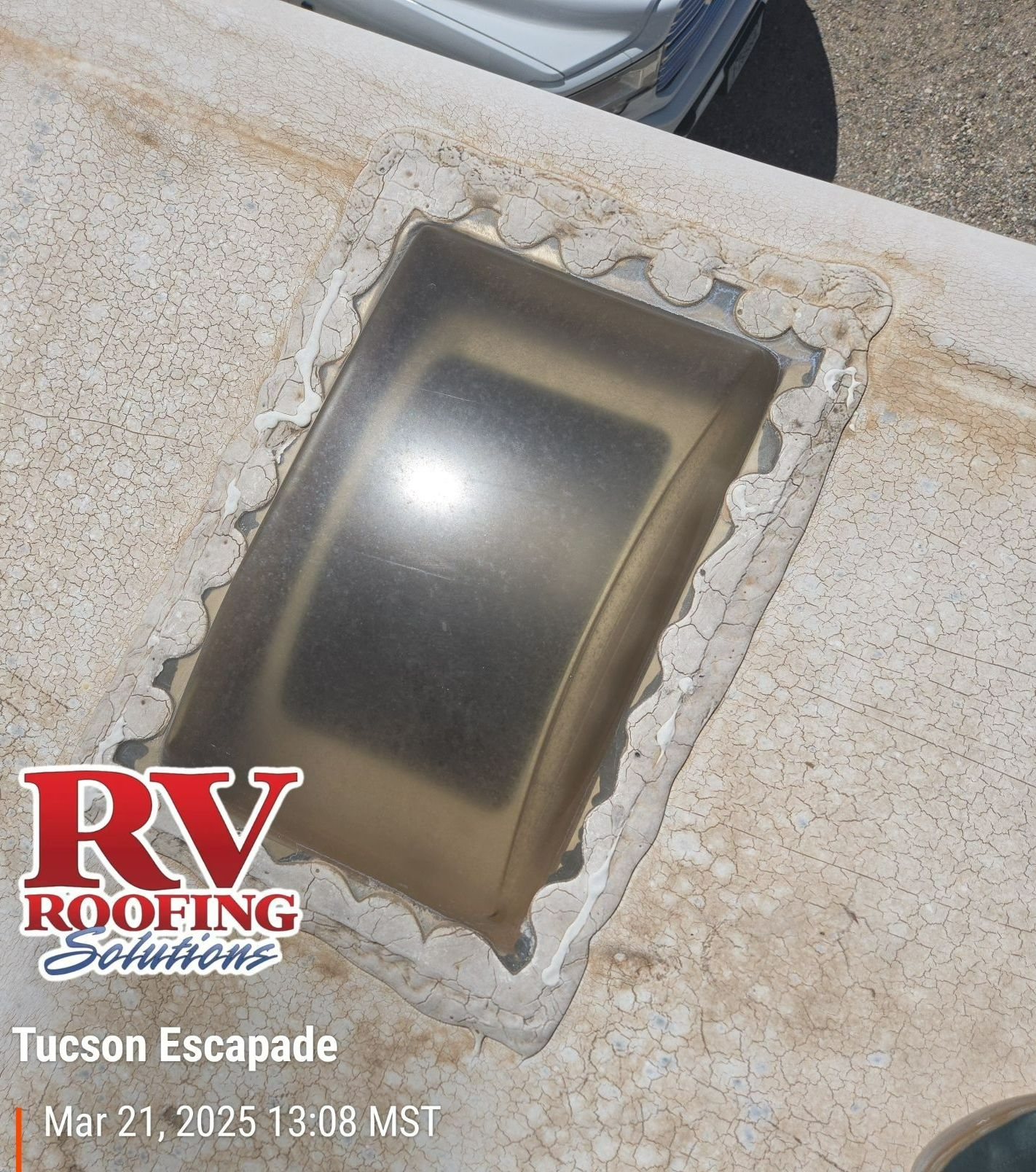
At RV Roofing Solutions, we love connecting with fellow RV enthusiasts at rallies, and to make your experience even better, we offer a FREE roof inspection for all attendees! While space is limited at rallies, you'll receive a detailed inspection report complete with photos showcasing your roof's condition, including detailed photos of the sealant. Whether you choose us, or not, we offer this service when we are at the same event- as long as the venue allows us to do so. Many folks initially say, "I don't need a roof" or "My roof is in good shape," but the images in this post tell a different story—they're from RVs whose owners chose not to proceed with our system. Remember, before sealing any roof, a thorough inspection is vital. Addressing leaks and underlying issues first can prevent costly long-term damage, ensuring your adventures stay leak-free. Begin by inspecting the entire surface, paying close attention to areas around vents, skylights, and other penetration points. Look for any gaps, separations, or signs of aging or weathering. This thorough inspection will help you determine the extent of the repairs needed and guide your decision on which sealant to use.

If you’re not sure whether you need a certified professional to replace your RV’s roof, we’re here to go into all the details of why it’s a good idea. Owning an RV opens up a world of adventure, combining the thrill of the open road with the comforts of home. But as much joy and excitement as RV ownership brings, it also comes with responsibilities, especially when it comes to maintenance. One crucial aspect of keeping your RV road-ready and safe is ensuring the roof is in top condition. However, when it comes time for a roof maintenance or replacement, you might wonder whether to take on the challenge yourself or turn to experienced professionals? Follow along as we explain why consulting & hiring certified professionals for your RV roof replacement is a smart move. You’ll learn about the risks of DIY repairs, the long-term benefits of professional services, and why choosing certified experts is a decision worth every penny. Why Your RV Roof Deserves the Best Care Your RV roof isn’t just a structural component; it’s your protection against the elements. At RV Roofing Solutions, we understand that Mother Nature doesn’t hold back when it comes to testing the durability of your RV roof. With rain, sun, snow, and wind relentlessly pounding on your investment, keeping your roof in tip-top shape is crucial. Over time, wear and tear are unavoidable, and neglecting roof issues can spiral into costly problems, like water damage and mold, not to mention a drop in your RV’s resale value. A solid and well-maintained roof translates to safety, comfort, and peace of mind on every trip. This is especially important if you frequently park your RV in harsh weather conditions or plan extended cross-country adventures. The Risks of Going the DIY Route At RV Roofing Solutions, we understand that your RV deserves only the best. That's why we offer top-notch aftermarket roofing systems and repairs that exceed industry standards, ensuring your roof is not just functional but also reliable. Our mobile installers are trained by our team. They come to you, making the process seamless and hassle-free. Plus, with our maintenance-free options, you can enjoy your travels without worrying about roof upkeep. Let us help you protect your investment and keep your adventures rolling! Unfortunately we see people attempt DIY rv roofing ALL the time. Often when people notice problems with an RV roof, they are tempted to grab some tools, watch a quick tutorial, and start fixing things. After all, how hard could it be? Unfortunately, DIY roof replacement or repair often does more harm than good, and we often see it's affects first hand. RV roofs are made with specialized materials like TPO, EPDM, or fiberglass. Identifying the right materials and correctly applying the right products can be challenging. Missteps can leave your roof susceptible to leaks or structural issues down the road. This can be as simple as using the wrong caulk for a peel and seal or trusting the latest and greatest fad. Fast immediate fixes with tape are sometimes necessary but tape shouldn't be a long term solution. UV rays can hrink even the best industry trusted tape leving tiny pathways where water might be getting in. And in this case, what you don't know CAN hurt your RV. RV roofing requires both precision and skill. Even a slight oversight, such as inadequate sealing or poor alignment, can compromise your roof’s integrity. What seems like a “job well done” today could lead to bigger problems tomorrow. Using a product to simply coat the roof can be daunting and often the final product flakes off for any number of reasons. This can lead to more costly repairs in the future. DIY fixes can even void any warranties on your RV. Manufacturers typically require certified professionals to perform repairs to maintain warranty validity. By going DIY, you risk losing a safety net for future repair costs. What Sets Certified Professionals Apart Certified RV repair professionals stand out for their knowledge, training, and commitment to quality service. They understand the intricate details of RV construction and roofing materials. This expertise minimizes the risk of future damage while allowing for a job that’s done right the first time. Most certified professionals have undergone rigorous training programs to gain their credentials. These programs cover RV-specific roofing materials, waterproofing techniques, and structural assessments. When you choose certified repair services, you’re trusting someone who knows the ins and outs of RV roofs—not just general construction. At RV Roofing Solutions, we know a non-certified fix might seem like a wallet-friendly choice at first glance, but the truth is that it can lead to costly repairs later on. Imagine discovering leaks or structural issues after a quick fix – suddenly, those savings evaporate. Quality Matters When It Comes to Material One of the lesser-known perks of hiring certified professionals is access to high-quality, industry-approved materials. Many general roofing supplies simply aren’t compatible with the unique design and demands of an RV roof. These materials not only create a strong roof but also contribute to greater energy efficiency and reduced maintenance over time. In most cases you simply cannot buy professional grade RV roofing products in stores. Deciding what to buy if you do a DIY coating is also daunting. All products are certainly not created equal. Beyond the materials themselves, the application process is equally important. Certified professionals follow exacting standards to ensure every layer is installed perfectly. From proper insulation to seamless waterproofing, their work reflects craftsmanship you can rely on. They Save You Time and Headache Maintaining or fixing an RV roof is an involved process that often takes many days of effort, especially when you’re navigating it solo. An RV Roofing Solutions professionally trained installer, typically takes a MINIMUM of 3 days to complete a standard install. In addition, certified professionals streamline the process while minimizing disruption to your day or to your travel plans Their experience allows them to work efficiently without sacrificing quality. From start to finish, certified repair teams follow a well-coordinated process. This includes thoroughly inpecting &cleaning roof, addressing any underlying structural issues, and installing the replacement material—using quality products and methods Meanwhile, hiring an expert saves you the stress of troubleshooting and trial-and-error techniques. At RV Roofing Solutions, we understand that your RV deserves only the best. That's why we offer top-notch aftermarket roofing systems and repairs that meet & exceed industry standards, ensuring your roof is not just functional but also reliable. Our mobile installers come to you, this means you don't have to drop it off to a shop and get it back weeks sor months later. This makes our insstall process seamless and hassle-free. Plus, with our maintenance-free options, you can enjoy your travels without worrying about roof upkeep. Let us help you protect your investment and keep your adventures rolling! Wouldn’t you rather focus on planning your next road trip than worrying about mistakes in your roof repair Warranty Protection Built-In Your RV is a significant investment, and protecting it is paramount. Hiring certified professionals ensures that your replacement roof comes with proper warranty coverage. That's why we offer a 10 year warranty on every roof we install our system on You want to be protected from a taillight guarantee. The only way to avoid the taillight guarantee is to do your homework before selecting a company. Yes, we know that it’s hard to find the time to research each company and their product. But if you don’t do your homework, and the work is not supported, you could run into trouble that’s not in your budget. Repair costs could easily exceed the savings by going with the lowest bid. Even if a non-certified fix seems cost-effective upfront, you could end up shouldering major repair expenses down the line. We had a client a few years back that ran into this. He had spent around $5,000.00 and thought his roof was fixed. He was in his late 70's and had not inspected the roof after the job by the other "reputable" company was complete. When his roof leaked and he called us just a year later he could not get that company to even pick up the phone to respond to his calls or reply to an email. His Newmar was outfitted for his wife's wheelchair and he couldn't go visit his kids. The damage the other company did was almost twice what they charged him. He needed all 10 sheets of his decking replaced. Unfortunately Bob's story is not as uncommon as you might think. Many certified RV technicians are authorized by manufacturers and service providers to perform warranty-backed work. There is a vetting process and quality control built right into the installation. That doesn't mean each independant contractor not partnered with a company like ours backs up their work. RV roofing Solutions installers sign an agreement that they will come back and fix your roof for FREE for 12 months past the installaion date. Then we as a company give you a full 10 year warranty. This ensures your new roof and repairs come with the quality control & coverage for years to come, giving you peace of mind We know there are companies out there offering a "lifetime" guarantee. We have also been around long enough to know that nothing last a lifetime. What many of those companies bank on is that you'll upgrade sooner that the warranty or they have clauses to get them out of honoring that warranty. At RV Roofing Solutions there is no fine print or hidden terms & conditions that you can only allowed to see after the work has been completed. The Long-Term Cost Benefit While hiring certified professionals may seem like a bigger upfront expense, it’s a worthwhile investment that saves you money in the long run. Proper materials and installation dramatically reduce the likelihood of premature repairs. You also avoid hidden issues like subpar insulation or water damage Furthermore, a properly maintained RV roof can increase resale value. Prospective buyers are often willing to pay a premium for an RV with a professionally replaced roof, as it conveys meticulous care and reliability. With an RV Roofing Solutions Complete system you get a 10 year trasferable warranty. This adds value to your RV and makes a professsionally installed roof a worthy investment. The Role of Customer Service Another perk of working with certified professionals is the high standard of customer service. From the moment you make an inquiry to the day your roof is complete, quality service providers prioritize your experience Our experienced office team will provide a one-on-one consultation, review photos and make sure you are informed at every step. Once your Install team is on-site they are our field experts, taking the time to explain their process and answer questions. If you ever have a question beyond that, you can always reach out to your assigned service advisor. In fact, if you see your technician on the phone... chances are they are checking in with the home office. Their service avisor is with your install team at every step of the install. They aim to provide not just a maintenance free rv roofing but also peace of mind. That peace of mind is invaluable when it comes to being out on the open road, knowing that your RV is in tip-top shape When It’s Time To Act If you suspect your RV roof needs attention, don’t delay. In fact, over 60% of our clients have our system installed BEFORE they ever have a leak. You can easily choose to have our system installed when you are due for their annual peel & seal as an alternative. Get a quote now and lock in the base price of a future install. Small issues can quickly snowball into costly problems- a pinhole leak can cause catastrophic damage if left unchecked. The sooner you address them, the sooner you can get back to enjoying your adventures worry-free Whether you are ready now or just want some information about our system or how to hire certified professionals for RV roof repairs or replacements, we are here to help you navigate that. RV Roofing Solutions has been offering the highest quality mobile RV roof replacement anywhere, so you can feel good about leaving your RV in our hands. We are actually one of the oldest aftermarket RV Roofing companies in the industry. You can fill out the form on the website or simply give us a call at 760-777-0564 for a one-on-one consultation. Click To Paste


